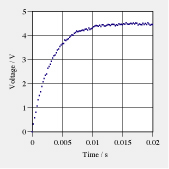A capacitor is hooked up to a (real) battery and a resistor. The circuit is closed and the capacitor charges (see the voltage across the capacitor as a function of time in the diagram). System parameters are to be determined with the help of a dynamical model. Resistance of the resistor, capacitance, and open circuit voltage and internal resistance of the battery are all unknown.
a. Determine the capacitive time constant of the circuit from the experimental data. b. Use the data to determine the open circuit voltage of the battery. (Why is it possible to get this parameter directly from the data?) c. Sketch the diagram of a system dynamics model of the circuit. Identify all necessary parameters. d. Write all the equations of the model. Introduce the constitutive laws in the single differential equation to transform it into a DE with U_C(t) as the unknown function. Show that U_C(t) = U_Bo·(1 – exp(–t/(RC))) is the solution of this equation. U_Bo is the open circuit voltage of the battery. e. What is the meaning of R in the solution in d? f. It turns out that we do not have enough data to fix the missing parameters. Why is it that any combination of R and C (where the product of R·C must always be the same) leads to a perfect fit of model and data? | | g. If you choose C = 200 µF, what would be the appropriate value of R? What would it be for C = 400 µF? Considering that the model correctly predicts U_C(t), is there anything different in the experiment for these two situations? h. Describe additional experiments to determine the missing parameters uniquely.
|

